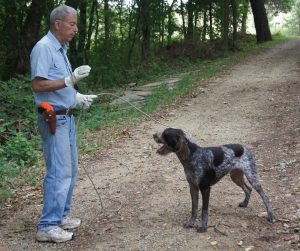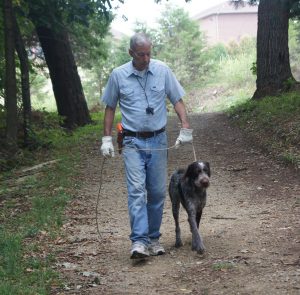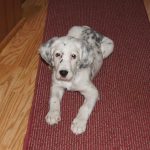Obedience Training and Field Work
POINTING DOG POINTERS April 2018
By Bob and Jody Iler
Recently we heard from Joe in Kansas City, who is developing his third German shorthair. “She is nine months old now and has had some exposure (running and exploring),” Joe says. “After the season I took her to a hunting preserve four times and she did great! Her pointing and drive are there as well as retrieving. The one issue I notice now is she takes off like a rocket. I know I need more obedience training with her and haven’t introduced the e-collar.”
First off, we want to congratulate Joe. He’s doing so many things right! The fact that his dog “takes off like a rocket” means he’s instilled enthusiasm and drive in his pup – and that excites us! That’s what every trainer strives for. And the fact that he has not yet introduced the e-collar means he’s conservative in his training approach and is focused on making things fun for his pup.
That being said, our conversation with Joe also indicated his pup is getting way out in front and busting birds when she takes off. Two things to note here: First, this is common with young pups that have developed hunt and drive; and secondly, now that the drive is instilled, it’s time to work on some control. And yes, “obedience” should help to do that. But again, if Joe hadn’t let his pup have fun and gain confidence, he might have a dog that is hanging close to him and not getting out there to find birds like a pointing dog should.
Young dogs without a lot of wild bird experience have not yet learned that they can’t catch the birds, hence the enthusiastic chase across the horizon. Once they do learn this valuable lesson, they begin to use more caution and point wild birds. With game preserve birds, the likelihood of a dog catching one is increased, and though this can happen now and then, we don’t want that to be the norm, as it could cause the pup to quit pointing and jump in on birds.
So – what do we do about control at this stage?
It’s time to go back to the basics of obedience or “yard work.” We want to intensify the bond of training with our pup, to establish or re-establish ourselves as the “leaders.” Yard work gives us the opportunity to make eye contact, mind to mind, as we remind our pup what we want from them: their attention and response to our commands.
Begin yard work sessions with some easy heeling exercises. Don’t just walk in straight lines; do lots of about turns and changes of pace to keep your dog guessing and watching you to see what’s coming next! Once you’ve got him hustling along and paying attention to you, you can begin to focus on fine-tuning the whoa.
Gently give this command as you slow to a stop while heeling and make him stand motionless for a bit. Resume heeling and interject several whoa stops into the session. Once pup is remaining still for you on a whoa at your side, move around and in front of him, gently reminding him to whoa. If he moves, physically place him back in the whoa position and quietly repeat the command.
Don’t be in a hurry to move to his front; make sure he stands motionless at your side well first. Once he stands well with you in front of him, move back a step or two, giving him the hand signal to whoa (palm up in front of him, like a stop signal). Repeated, gentle drills like this establish a good foundation on the whoa command before you head to the field.
Next, you’ll get out one of your best training aids – your 15- to 20-foot checkcord! If pup is paying attention to you in yard sessions, heeling at your side, and will whoa at your command, it’s time to add control work in the field. For these sessions, we don’t want to have birds in the field! We want the pup to be focusing on you, your commands, and the direction you are walking in.
Begin by walking in a wide, zig-zag pattern. Pup will have her own ideas about where she wants to go, but just as you did in the yard, you want to have that “meeting of the minds” in the field as well. By zig-zagging back and forth, your pup will have to pay attention to the direction you’re walking in. Each time you change direction, if pup is going the opposite way, pop the checkcord, blow your whistle or give a voice command, and walk briskly in the new direction. Pup will have no choice but to change direction with you.
This exercise is teaching her to pay attention to where you are going and to the whistle or voice command you are using when you change direction. Later on, we want our pointing dog to get out and hunt the birdy objectives, but this groundwork helps to teach the young dog that she is part of a team, and should respond to your commands.
While you work on zig-zag quartering sessions in the field, this is also the time to re-instill the come or here command. Surprise your dog now and then with the command to come as you quarter in the field. Make sure you enforce this command by using your checkcord to guide her directly and briskly to you. During these sessions, be sure to praise your pup often when she does what you ask!
Think now about a dog that doesn’t take off like a rocket, perhaps one that just doesn’t show a lot of enthusiasm yet. If you put a lot of control in this type of pup, you are taking away from the development of that drive and hunt that needs to come out! This is why we want our pup to be excited and raring to go, before we start to work on more control!
Once we have our pup following our change of direction commands well and coming reliably when called in the field, it’s time to add a bird or two back into the equation. For young pups like Joe’s, we’ll want to use the checkcord so that we can gently restrain the pup once she goes on point. Having a helper to flush the bird while you handle your pup on the checkcord makes this easier.
At this young, inexperienced age, we don’t want to dampen pup’s enthusiasm, so we’re not trying to steady our pup to a wild flush, or to wing, or wing and shot. We just want to instill some control as pup hunts and goes on point.
This is also not the time to introduce the e-collar as a means of control. Pups that haven’t made the whole connection by hunting for a season or two are not ready for this type of control training. More harm than good can result from using the e-collar too soon.
Probably one of the best things to remember as you travel along the path of developing your pointing dog puppy is this: You can always put the control into your dog but first, let them be pups, to make mistakes, learn, and have fun!
Pointing Dog Pointers features monthly training tips by Bob and Jody Iler, who own Green Valley Kennels in Dubuque, Iowa. Bob and Jody have trained pointing dogs for over 35 years and have written many articles for The Pointing Dog Journal.







